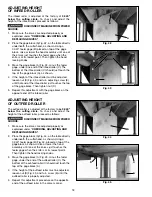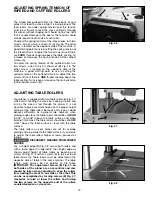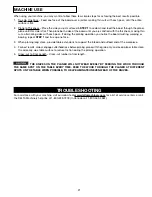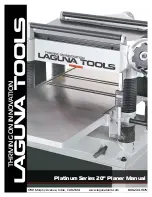
19
ADJUSTING SPRING TENSION OF
INFEED AND OUTFEED ROLLERS
The infeed and outfeed rollers are those parts of your
planer that feed the stock while it is being planed. The
feed rollers are under spring tension and this tension
must be sufficient to feed the stock uniformly through
the planer without slipping but should not be too tight
that it causes damage to the board. The tension should
also be equal at both ends of each roller.
To adjust the spring tension of the infeed roller, turn two
screws, one of which is shown at (A) Fig. 46. The other
screw is located on the opposite side of the machine. A
good starting point to use in setting the spring tension of
the infeed roller is to adjust the two screws (A) until there
are
FOUR
threads showing above the table casting. To
increase or decrease the spring tension further, adjust
screws (A).
To adjust the spring tension of the outfeed roller, turn
two screws, one of which is shown at (B) Fig. 46. The
other screw is located on the opposite side of the
machine. A good starting point to use in setting the
spring tension of the outfeed roller is to adjust the two
screws (B) until there is
ONE
thread showing above the
table casting. To increase or decrease the spring tension
further, adjust screws (B).
Fig. 46
Fig. 47
Fig. 48
ADJUSTING TABLE ROLLERS
Your planer is supplied with two table rollers (A) Fig. 47,
which aid in feeding the stock by reducing friction and
turn as the stock is fed through the planer. It is not
possible to give exact dimensions on the proper height
setting of the table rollers because each type of wood
behaves differently. As a general rule, however, when
planing rough stock the table rollers should be set
HIGH
(0.003" to 0.005") above the table surface and when
planing finish stock the table rollers should be set
LOW,
0.001" above the table surface or level with the table
surface.
The table rollers on your planer are set for average
planing and are parallel to the table surface. If you desire
to adjust the table rollers higher or lower, proceed as
follows:
DISCONNECT MACHINE FROM POWER
SOURCE
.
Lay a straight edge (B) Fig. 48, across both rollers and
with a feeler gage (C) underneath the straight edge as
shown, adjust height of table rollers by loosening set
screws (D) Fig. 47, and turn screws (E) to raise or lower
table rollers (A). Table rollers must be adjusted on the
opposite side of table in the same manner. The table
rollers must always be set parallel to the table.
IMPORTANT: The adjustment screws (E) Fig. 47, on
both sides of the planer are on eccentrics and care
should be taken when adjusting to keep the rollers
from leading the stock to one side or the other. This
can be accomplished by turning screws (E) Fig. 47,
clockwise to raise or lower the rollers and turning
the two screws on the opposite end of the rollers
counterclockwise or vice versa
.
A
B
A
D
D
E
E
B
C






































